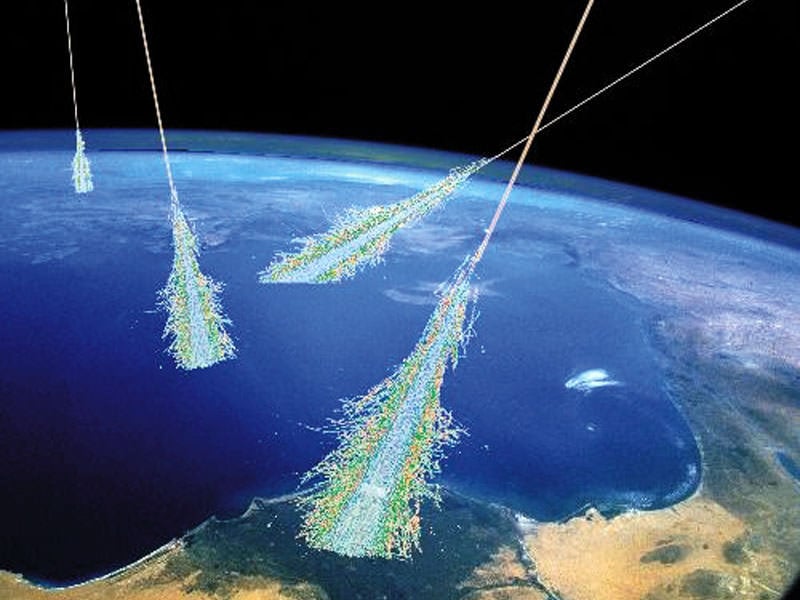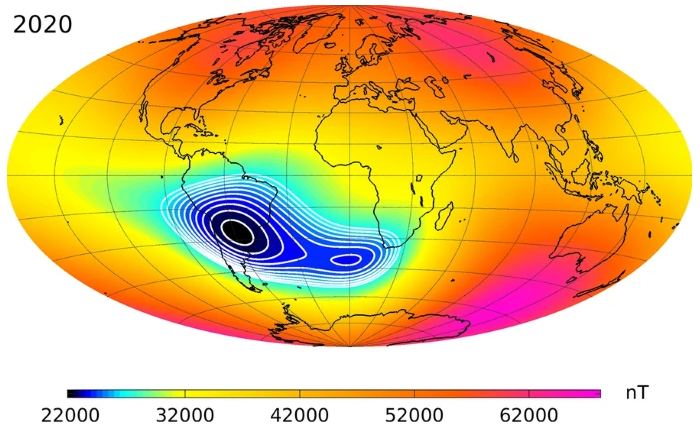Earth is naked without its protective barrier. The planet's magnetic shield surrounds Earth and shelters it from the natural onslaught of cosmic rays. But sometimes, the shield weakens and wavers, allowing cosmic rays to strike the atmosphere, creating a shower of particles that scientists think could wreak havoc on the biosphere.
This has happened many times in our planet's history, including 41,000 years ago in an event called the Laschamps excursion.
Cosmic rays are high-energy particles, usually protons or atomic nuclei, that travel through space at relativistic speeds. Normally, they're deflected into space and away from Earth by the planet's magnetic shield. But the shield is a natural phenomenon and its strength fluctuates, as does its orientation. When that happens, cosmic rays strike the Earth's atmosphere.
That creates a shower of secondary particles called cosmogenic radionuclides. These isotopes become embedded in sediments and ice cores and even in the structure of living things like trees. There are different types of these isotopes, including ones like Calcium 41 and Carbon 14.
Some of the isotopes are stable, and some are radioactive. The radioactive ones have half-lives ranging from only 20 minutes (Carbon 11) up to 15.7 million years (Xenon 129.)
When Earth's shield weakens, more of these isotopes reach the planet's surface and collect in sediments and ice. By studying these cores and sediments, scientists can determine the magnetic shield's history. Their observations show that Earth experienced a geomagnetic excursion or reversal 41,000 years ago. It's called the Laschamps excursion after the Laschamps lava flows in France, where geomagnetic anomalies revealed its occurrence.
Every few hundred thousand years, the Earth's magnetic poles flip. North becomes South and vice versa. In between those major events are more minor events called excursions. During excursions, the poles shift around for a while without swapping places. The excursions weaken the Earth's shield and can last from a few thousand to tens of thousands of years. When that happens, more cosmic rays strike the atmosphere, creating more radionuclides that shower down onto Earth.
Scientists often focus on one particular radioactive isotope in paleomagnetic studies. Beryllium 10 has a relatively long half-life of 1.36 million years and tends to accumulate on the soil surface.
Sanja Panovska is a researcher at GFZ Potsdam, Germany, who studies geomagnetism. At the recent European Geosciences Union (EGU) General Assembly 2024, Panovska presented new research on the Laschamps excursion. She found that during the Laschamps excursion, production of Be 10 was twice as high as normal.
To understand the Laschamps excursion more thoroughly, Panovska combined cosmogenic radionuclide and paleomagnetic data to reconstruct the Earth's magnetic field at the time. She found that when the field decreased in strength, it also shrank. The transition from normal field to reversed field took about 250 years, and it stayed flipped for about 440 years. During the transition, the Earth's shield weekend to as little as 5% of its normal strength. When it was fully reversed, it was at about 25% of its regular strength. This weakening allowed more Be 10 and other cosmogenic radionuclides to reach Earth's surface.
These radionuclides do more than collect in sediments and ice. Some of them are radioactive. The weakening of the shield also weakened the ozone layer, letting more UV radiation reach Earth's surface. The high-altitude atmosphere also cooled, which changed the wind flows. This could've caused drastic changes on the Earth's surface.
For these reasons, the Laschamps event has been linked to the extinction of the Neanderthals, the extinction of Australian megafauna, and even to the appearance of cave art. Those links haven't withstood scientific scrutiny, but that doesn't mean that events like the Laschamps event aren't hazardous. If it occurred now, it would knock out our power grids. The Earth's equatorial region would light up with aurorae.
"Understanding these extreme events is important for their occurrence in the future, space climate predictions, and assessing the effects on the environment and on the Earth system," Panovska said.
Scientists are learning that the magnetic shield isn't static. There are anomalies. One of them is the South Atlantic Anomaly, a region where the magnetic field is weakest near Earth. When satellites pass over this region, they're exposed to higher levels of ionizing radiation. The anomaly is likely caused by a reservoir of dense rock inside Earth, illustrating how complex the magnetic shield is.
Scientists are uncertain about what effect the cosmic rays have on life when the magnetic shield is weak. It's tempting to correlate extinctions with events like the Laschamps excursion when they line up temporally. But the poles have shifted, weakened, and reversed many times and life is still here and still thriving.
If humanity lasts long enough, we'll go through one of these reversals. Then we'll know.
 Universe Today
Universe Today


![Each map shows the intensity of Earth's geomagnetic field at different snapshots in time, according to Panovska's reconstructions that are constrained by both paleomagnetic data and records of cosmogenic beryllium-10 radionuclides. DM stands for Dipole Moment, which is a measure of the field's polarity or separation of positive and negative. Age [ka BP] is the age measures in thousands of years before the present. Image Credit: Sanja Panovska.](/article_images/Panovska-summary-map.jpg)
